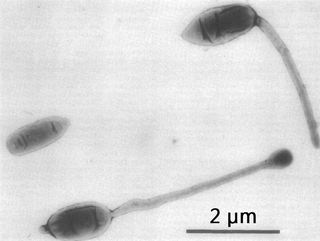Related Research Articles

Enterobacteriaceae is a large family of Gram-negative bacteria. It includes over 30 genera and more than 100 species. Its classification above the level of family is still a subject of debate, but one classification places it in the order Enterobacterales of the class Gammaproteobacteria in the phylum Pseudomonadota. In 2016, the description and members of this family were emended based on comparative genomic analyses by Adeolu et al.

Mycoplasma is a genus of bacteria that, like the other members of the class Mollicutes, lack a cell wall around their cell membranes. Peptidoglycan (murein) is absent. This characteristic makes them naturally resistant to antibiotics that target cell wall synthesis. They can be parasitic or saprotrophic. Several species are pathogenic in humans, including M. pneumoniae, which is an important cause of "walking" pneumonia and other respiratory disorders, and M. genitalium, which is believed to be involved in pelvic inflammatory diseases. Mycoplasma species are among the smallest organisms yet discovered, can survive without oxygen, and come in various shapes. For example, M. genitalium is flask-shaped, while M. pneumoniae is more elongated, many Mycoplasma species are coccoid. Hundreds of Mycoplasma species infect animals.

Verrucomicrobiota is a phylum of Gram-negative bacteria that contains only a few described species. The species identified have been isolated from fresh water, marine and soil environments and human faeces. A number of as-yet uncultivated species have been identified in association with eukaryotic hosts including extrusive explosive ectosymbionts of protists and endosymbionts of nematodes from genus Xiphinema, residing in their gametes.
The Thermomicrobia is a group of thermophilic green non-sulfur bacteria. Based on species Thermomicrobium roseum and Sphaerobacter thermophilus, this bacteria class has the following description:

The Burkholderiales are an order of Pseudomonadota. Like all Pseudomonadota, they are Gram-negative. They include several pathogenic bacteria, including species of Burkholderia, Bordetella, and Ralstonia. They also include Oxalobacter and related genera, which are unusual in using oxalic acid as their source of carbon. Other well-studied genera include Alcaligenes, Cupriavidus, Achromobacter, Comamonas, Delftia, Massilia, Duganella, Janthinobacterium, Polynucleobacter, non-pathogenic Paraburkholderia, Caballeronia, Polaromonas, Thiomonas, Collimonas, Hydrogenophaga, Sphaerotilus, Variovorax, Acidovorax, Rubrivivax and Rhodoferax, and Herbaspirillum.

The Hyphomicrobiaceae are a family of bacteria. Among others, they include Rhodomicrobium, a genus of purple bacteria.

The Oceanospirillales are an order of Pseudomonadota with ten families.

The Burkholderiaceae are a family of bacteria included in the order Burkholderiales. It includes some pathogenic species, such as Burkholderia mallei (glanders) and Burkholderia pseudomallei (melioidosis). This family was found to be enriched in scale-eating pupfish guts, even after being fed a common laboratory diet, suggesting it may aid in scale-digestion.
The Thermotogota are a phylum of the domain Bacteria. The phylum Thermotogota is composed of Gram-negative staining, anaerobic, and mostly thermophilic and hyperthermophilic bacteria.
The Alicyclobacillaceae are a family of Gram-positive bacteria. All members of this family are aerobic and form endospores.
Sphingobacteriaceae is a family of environmental bacteria.
The Chloroflexota are a phylum of bacteria containing isolates with a diversity of phenotypes, including members that are aerobic thermophiles, which use oxygen and grow well in high temperatures; anoxygenic phototrophs, which use light for photosynthesis ; and anaerobic halorespirers, which uses halogenated organics as electron acceptors.
Nitrospirota is a phylum of bacteria. It includes multiple genera, such as Nitrospira, the largest. The first member of this phylum, Nitrospira marina, was discovered in 1985. The second member, Nitrospira moscoviensis, was discovered in 1995.
Chloroflexales is an order of bacteria in the class Chloroflexia. The clade is also known as filamentous anoxygenic phototrophic bacteria (FAP), as the order contains phototrophs that do not produce oxygen. These bacteria are facultative aerobic. They generally use chemotrophy when oxygen is present and switch to light-derived energy when otherwise. Most species are heterotrophs, but a few are capable of photoautotrophy.
Coprothermobacterota is a phylum of nonmotile, rod-shaped bacteria.
Coprothermobacter is a genus of rod-shaped microorganisms, belonging to the bacterial family Coprothermobacteraceae of the phylum Coprothermobacterota. This taxonomic genus has been reclassified in 2018, after different phylogenetic studies showed that these bacteria represented a deeply branched taxon of the domain Bacteria; consequently, the clade including this genus has been classified in a separate phylum from Firmicutes, the phylum where it was included before reclassification.
Cytophagales is an order of non-spore forming, rod-shaped, Gram-negative bacteria that move through a gliding or flexing motion. These chemoorganotrophs are important remineralizers of organic materials into micronutrients. They are widely dispersed in the environment, found in ecosystems including soil, freshwater, seawater and sea ice. Cytophagales is included in the Bacteroidota phylum.
Emcibacteraceae is a family of bacteria.
Iodidimonas is a genus of bacteria that oxidizes iodide to iodine. It was isolated from iodide-rich brine associated with natural gas in Kujukuri, Japan.
Euzebya is a genus of Gram-positive bacteria.
References
- 1 2 "Genus: Geminisphaera". LPSN.DSMZ.de.
- ↑ Wertz, John T.; Kim, Eunji; Breznak, John A.; Schmidt, Thomas M.; Rodrigues, Jorge L. M. (March 2012). "Genomic and Physiological Characterization of the Verrucomicrobia Isolate Diplosphaera colitermitum gen. nov., sp. nov., Reveals Microaerophily and Nitrogen Fixation Genes". Applied and Environmental Microbiology. 78 (5): 1544–1555. Bibcode:2012ApEnM..78.1544W. doi:10.1128/AEM.06466-11. PMC 3294482 . PMID 22194293.